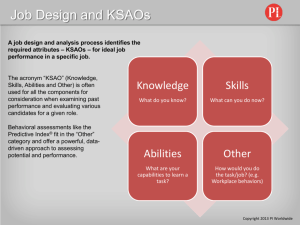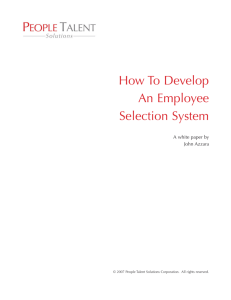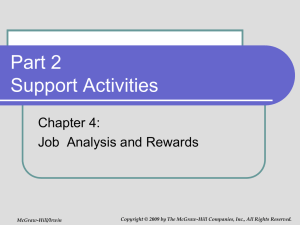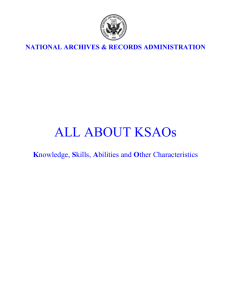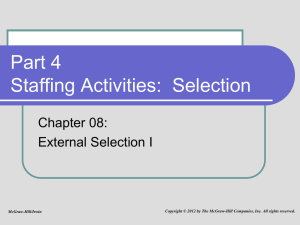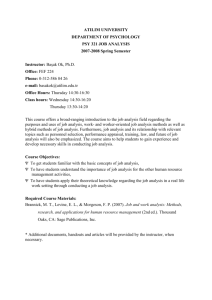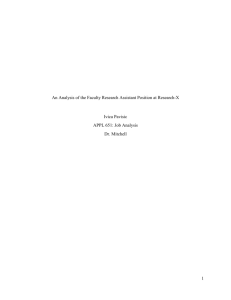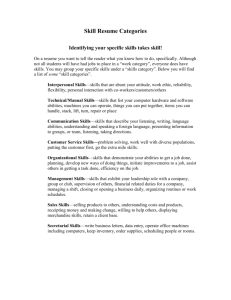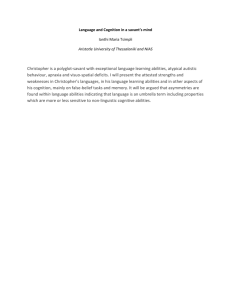W4 HR Matrix Assignment
advertisement
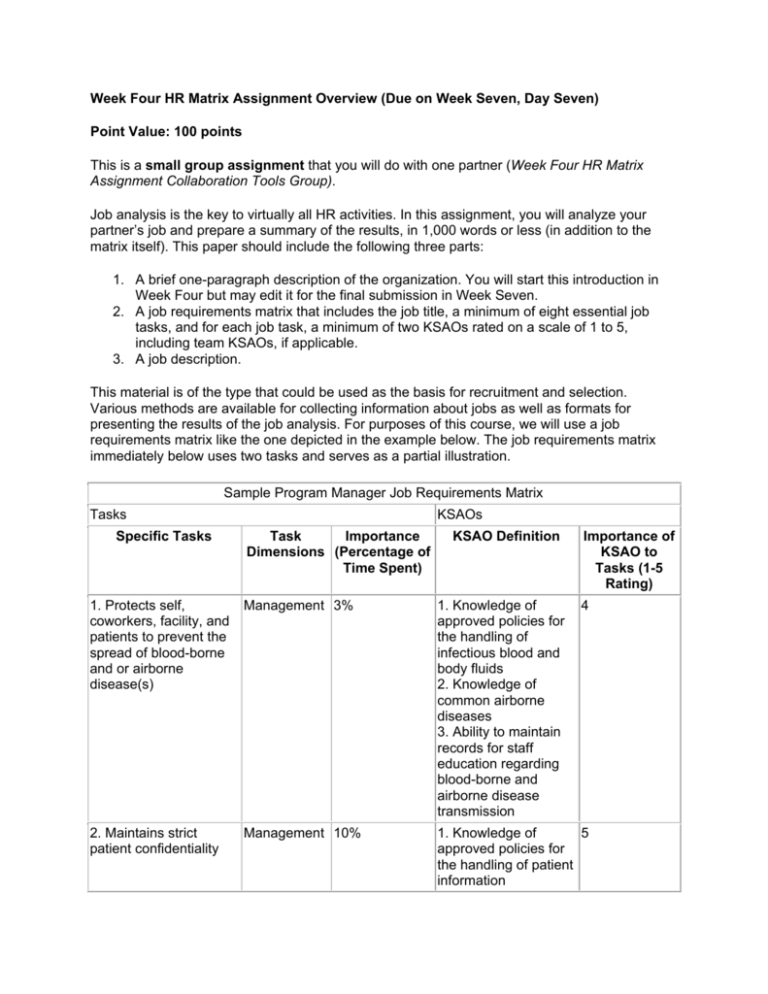
Week Four HR Matrix Assignment Overview (Due on Week Seven, Day Seven) Point Value: 100 points This is a small group assignment that you will do with one partner (Week Four HR Matrix Assignment Collaboration Tools Group). Job analysis is the key to virtually all HR activities. In this assignment, you will analyze your partner’s job and prepare a summary of the results, in 1,000 words or less (in addition to the matrix itself). This paper should include the following three parts: 1. A brief one-paragraph description of the organization. You will start this introduction in Week Four but may edit it for the final submission in Week Seven. 2. A job requirements matrix that includes the job title, a minimum of eight essential job tasks, and for each job task, a minimum of two KSAOs rated on a scale of 1 to 5, including team KSAOs, if applicable. 3. A job description. This material is of the type that could be used as the basis for recruitment and selection. Various methods are available for collecting information about jobs as well as formats for presenting the results of the job analysis. For purposes of this course, we will use a job requirements matrix like the one depicted in the example below. The job requirements matrix immediately below uses two tasks and serves as a partial illustration. Sample Program Manager Job Requirements Matrix Tasks Specific Tasks KSAOs Task Importance Dimensions (Percentage of Time Spent) KSAO Definition Importance of KSAO to Tasks (1-5 Rating) 4 1. Protects self, coworkers, facility, and patients to prevent the spread of blood-borne and or airborne disease(s) Management 3% 1. Knowledge of approved policies for the handling of infectious blood and body fluids 2. Knowledge of common airborne diseases 3. Ability to maintain records for staff education regarding blood-borne and airborne disease transmission 2. Maintains strict patient confidentiality Management 10% 5 1. Knowledge of approved policies for the handling of patient information Using your current jobs, you and your partner will interview each other sufficiently to create a matrix and job description for each other’s positions. Each of you will need to make the needed information available to one another. This assignment requires that you conduct a job analysis (collect information about a job) and record this information in the job requirements matrix. For our purpose, the process of job analysis has been abbreviated and overly simplified. A properly conducted job analysis may take weeks or months to complete. The goal of this assignment is to provide a simulated experience of the job analysis process. Nevertheless, even in abbreviated form, this process often results in interesting discoveries about existing jobs. This is particularly common in organizations with “stale” (have not been reviewed for some time) job descriptions. Completing a Job Requirements Matrix and Constructing the Job Description Use the following template to complete your job requirements matrix and job description. Click the link provided below to download the HR Matrix Assignment Template. HR Matrix Assignment Template The following information is recorded in such a matrix: Specific tasks are recorded for the job. Each task statement should include what the employee does, what is produced, and what materials or procedures are used. For example, the matrix shown at the bottom of this assignment shows a set of specific tasks for the job of program manager for a hospital-based community outreach health promotion program. Twelve specific tasks are listed for this job. Two specific tasks are listed for this job analysis as an example. There are obviously several more tasks (for example, there could be a total of 8, 10, or 12 depending on the job) that would be included and the total percentage of time spent should equal 100% once all tasks are identified. Several related tasks may be grouped into a broader category or task dimension. In the program manager job example, note that the 2 specific tasks have been grouped into four task dimensions: management, analysis, supervision, and public relations. In the sample job requirements matrix, note that the specific tasks have been grouped under management. Task dimensions could also include: analysis, supervision, public relations, and training as examples. For each specific task or task dimension, the job analyst assigns a “level of importance” score, measured by the percentage of time spent on the task. These percentages may be recorded for each specific task or for each task dimension. In this instance, each specific task is rated separately, although the relative importance of each task dimension can be simply determined by adding the percentages for each specific task associated with the four task dimensions. KSAO refers to knowledge, skills, abilities, and other personal characteristics necessary for successful job performance. Knowledge refers to a body of information that is necessary for an employee to know and may be conceptual, factual, or procedural. Skill refers to what a person is able to do on the job (and observable competence) and may include mental and physical tasks. Abilities include cognitive, physical, psychomotor, and sensory abilities. These are different from skills in that they are less likely to change over time and are applicable across a wide set of tasks required in different jobs. Other personal characteristics (not covered by the first three) include attitudes, beliefs, personality, temperament, and values. The job analyst records the relevant KSAOs for each specific task (or task dimension) and indicates the relative importance of the KSAO on a scale that ranges from 1 (least important) to 5 (most important). The Job Description The job description is a written summary of the job and is a direct outcome of the job analysis process. The most common elements of a job description are as follows: Job identification, including job title and FLSA status Job overview, including mission of the job and the products and services produced by the employee Organizational placement of the job, including reporting relationships The specific tasks involved in the job A list of equipment, machines, and tools used Raw materials, goods, data, or other materials used in the job The processes used to transform materials into products and services Guidelines and controls that limit the discretion of the worker, including supervision KSAOs Work context, including work setting, work attire, body positioning, environmental conditions, and job hazards Qualifications, including experience, education, certification, and licensure There may certainly be variations on these elements. For example, pay grade and job classification may be included, depending on the organization. Additional information may also be included in job descriptions for unionized employees. The important point, regardless of the precise format used, is that the job description should be a living and useable management tool. The job description is used as the basis for training, performance appraisal, compensation decisions, disciplinary actions, and other functions. As such, organizations must ensure that job descriptions are accurate and current. A Note on Teams In large measure, the previous discussion has treated jobs as if they were isolated and unrelated to other jobs. Team participation is often ignored in job descriptions, yet when we interview candidates for jobs, the issue of “ability to work in teams” is often viewed as a critically important ability, skill, and attitude. In fact, this ability often makes the difference between two equally qualified candidates. If team abilities are important, why not include them as a KSAO in a job analysis? Teams play a prominent role in healthcare organizations, yet we often use a general term such as “team player” to refer to a whole configuration of KSAOs. Consider the following more specific KSAOs in relation to individuals’ ability to participate effectively in teams. Note that these are suggestive, but they do illustrate the potential for identifying KSAOs related to this seemingly amorphous area: Knowledge: 1. 2. 3. 4. 5. 6. 7. Appreciates the need for teams in the specific work setting Knows potential problems in the management of teams Understands sources of intra-team conflict and alternative conflict resolution strategies Knows the predictable stages of team development Understands how status differences affect participation in teams Knows rules and principles for managing a meeting Knows principles of engaging maximum individual contributions in teams and meetings Skills 1. Can effectively manage conflict in a team setting 2. Is able to set a meeting agenda using logic that supports effective priority-setting, productivity, and efficiency 3. Can elicit input from multiple group members 4. Is able to moderate discussion to facilitate input and prevent domination 5. Can effectively distribute tasks to team members and subgroups and summarize meeting deliberations 6. Can effectively communicate with team members during and between team meetings using appropriate communication media Abilities 1. 2. 3. 4. 5. Strong written and oral communication abilities Demonstrated insight into interpersonal dynamics Strong interviewing abilities Sensitivity to conflict and dissonance in group settings Insight into one’s own strengths and weaknesses as a team leader and member, and ability to manage oneself in a team setting Several points are important. First, we can in fact identify specific KSAOs related to team performance. This list is suggestive, but it can get a job analyst to ask the right questions to determine the relevant KSAOs for a particular job’s team responsibilities. Second, the above list illustrates that other difficult-to-measure characteristics can be measured if we can first articulate the key KSAOs. Finally, in identifying KSAOs, being specific and not being dissuaded are important because of potential difficulties in measuring certain phenomena. At this stage, we are simply interested in identifying the KSAOs that will increase the probability of successful job performance. In the discussion of recruitment and selection, we will address the subject of measuring these KSAOs and suggest some innovative ways to come up with valid and reliable measures. Assignment Summary As noted earlier, this assignment should include: 1. A brief one-paragraph description of the organization. 2. The job requirements matrix including team KSAOs, if applicable. 3. The job description that includes the common elements in the order listed above. The job description should flow from the information collected through the job analysis and describe the job as it currently exists (even if it has evolved). Note: In Week Four Assignment Two you will complete the one-paragraph description of your partner's organization; then you will work with your partner to complete the deliverables given above by the deadline given. Contact your partner through your group discussion board by 11:59 PM PT of Day Three of this week, and continue to check in on a weekly basis throughout the course. Students who do not actively communicate with their group members via the discussion board regularly throughout the course could be liable to grade reduction according to the peer evaluation standards. Go to Quick Links for the writing assignment grading rubrics. Note that you will be evaluating your partner on his or her contribution to this assignment using a Peer Evaluation Form in Weeks Five and Seven. Your final HR Matrix assignment grade may be modified by the total peer evaluation scores you receive throughout the project and your facilitator’s observations of your participation in the project. We want to assure that all group members’ grades adequately reflect their participation in the project and that inadequate participation will be reflected in a student’s grade. Submit your assignment on Week Seven, by 11:59 PM PT of Day Seven. For global feedback and to ask questions about this assignment’s grading, please check the Assignments Feedback Forum once grading has been completed.
